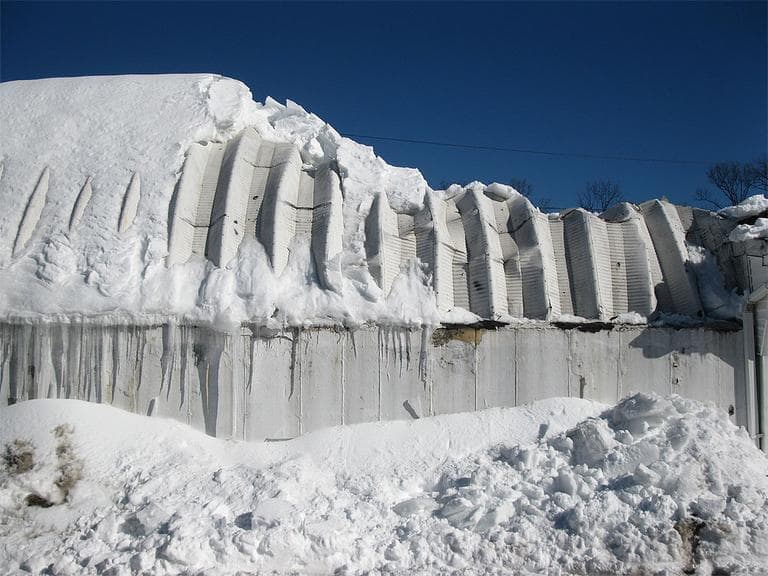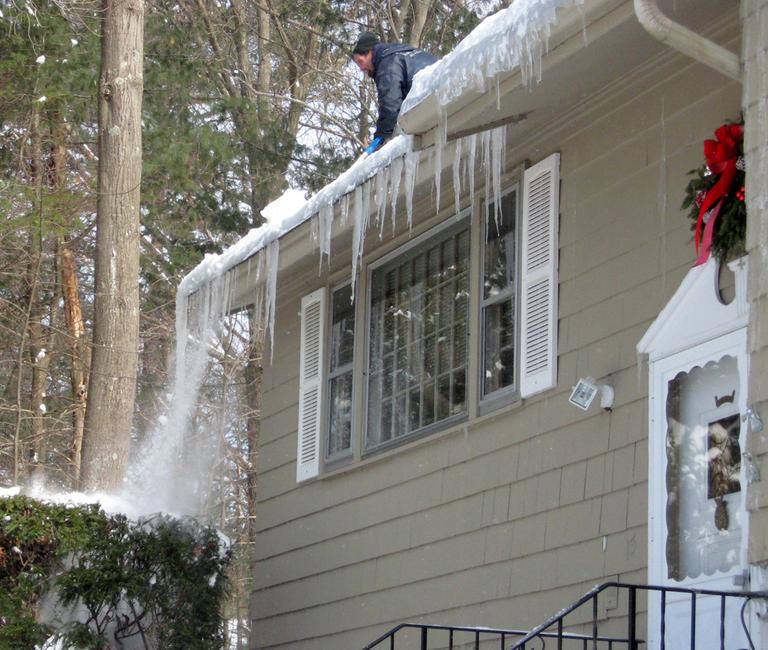Advertisement
FAQ: What To Do If You Worry About Roof Collapses, Ice Dams
We've been hearing this week about an unprecedented number of roof collapses in Massachusetts due to all the accumulation of snow. Most of the collapses have been flat-roofed industrial buildings, but that has many homeowners wondering if they should be concerned, as well.
To find out more about when a residential roof is at risk, and whether an ice dam may be developing on a house, WBUR's All Things Considered host Sacha Pfeiffer spoke with Prof. Garrick Goldenberg, a registered structural engineer who teaches at the Wentworth Institute of Technology and is the chief structural engineer at Chappell Engineering Associates in Marlborough.
Sacha Pfeiffer: If you're a homeowner with a house with a traditional pitched, angled roof, does that mean you shouldn't be concerned?
Prof. Garrick Goldenberg: No, it doesn't mean that just because you have a pitched roof, you're OK. The steeper the roof, you probably are in better shape in terms of structural collapse.

So if you're a homeowner with a roof that is an angled roof, how would you know whether you have a problem?
Try to get into your attic and see if your roof rafters are either deflecting, sagging, creaking or making any noise.
And if you have a sense that your roof might be compromised, what should you do to get the snow off your roof?
Unless you could reach it from the ground — say you have a ranch house or you could reach it with something with a long handle — I would strongly recommend getting a professional to do it. It makes no sense to risk your life for an unknown risk to your roof.
Boston has a lot of three-family houses that have flat roofs. Should people who live in or own three-deckers be concerned?
Anything that has a flat roof definitely requires a good look at it. Just to give you a number, fresh-fallen snow could weigh anything from 5-6 pounds per foot to 20 pounds per foot, depending on how compacted it gets. Ice would weigh 60 pounds per foot. Houses would have been designed for 30 pounds per foot of snow per square foot on the roof.
So if a homeowner is concerned that there may be so much snow on his or her roof that it's at risk of collapsing, your advice is that if you can safely remove it, do it yourself. And if you can't, hire someone.
If you can safely do it because you can reach your roof and you have a long-handled rake, how much snow do you need to get off? Just a little? Or just the edges? Or just enough to redistribute the load?
If you have more than a foot of snow, I would recommend trying to remove it.
The other big problem homeowners are having is ice dams. Give us a simple definition of an ice dam.
What happens in weather like this is that gutters fill with snow, the water builds up at that snow, and as the snow rises and ice is created at the edge of the roof, that water rises and gets under the shingles, and the water will start getting into insulation. And eventually — if there's enough water — it will get into the attic and you will see it in your ceiling as a stain.

If a house doesn't have gutters, can it not develop an ice dam?
Under normal circumstances, it should not.
If you have an ice dam developing in your gutter, is there a risk of the gutter being torn off by the weight?
Yes, there is.
I suspect I may have an ice dam at my house. There's a giant mound of ice that's formed in the gutter in front of my house. It's going up and over the gutter, and there's an enormous amount of icicles developing at our rim. Does that sound like an ice dam to you? And are those the typical signs: big mounds of ice in a gutter and lots of icicles?
Yes, that's right.
So what is the short-term solution for removing ice dams?
I think you have to balance the safety. If that gutter falls off and doesn't kill anybody it's still better than you fall off the roof and have structural damage to your body.
If you suspect you have an ice dam or you know you have an ice damn and you don't want to risk leaks to your roof and ceilings, whom should you contact to remove that ice if it's not safe for you to do it by yourself?
You probably would contact a roofing company.
When we have sunny, thawing days, are those opportunities for homeowners to get snow off their roofs and ice out of their gutters before the next storm comes?
Absolutely, because these sunny days are also contributing to the build-up of ice.
This program aired on February 4, 2011.
